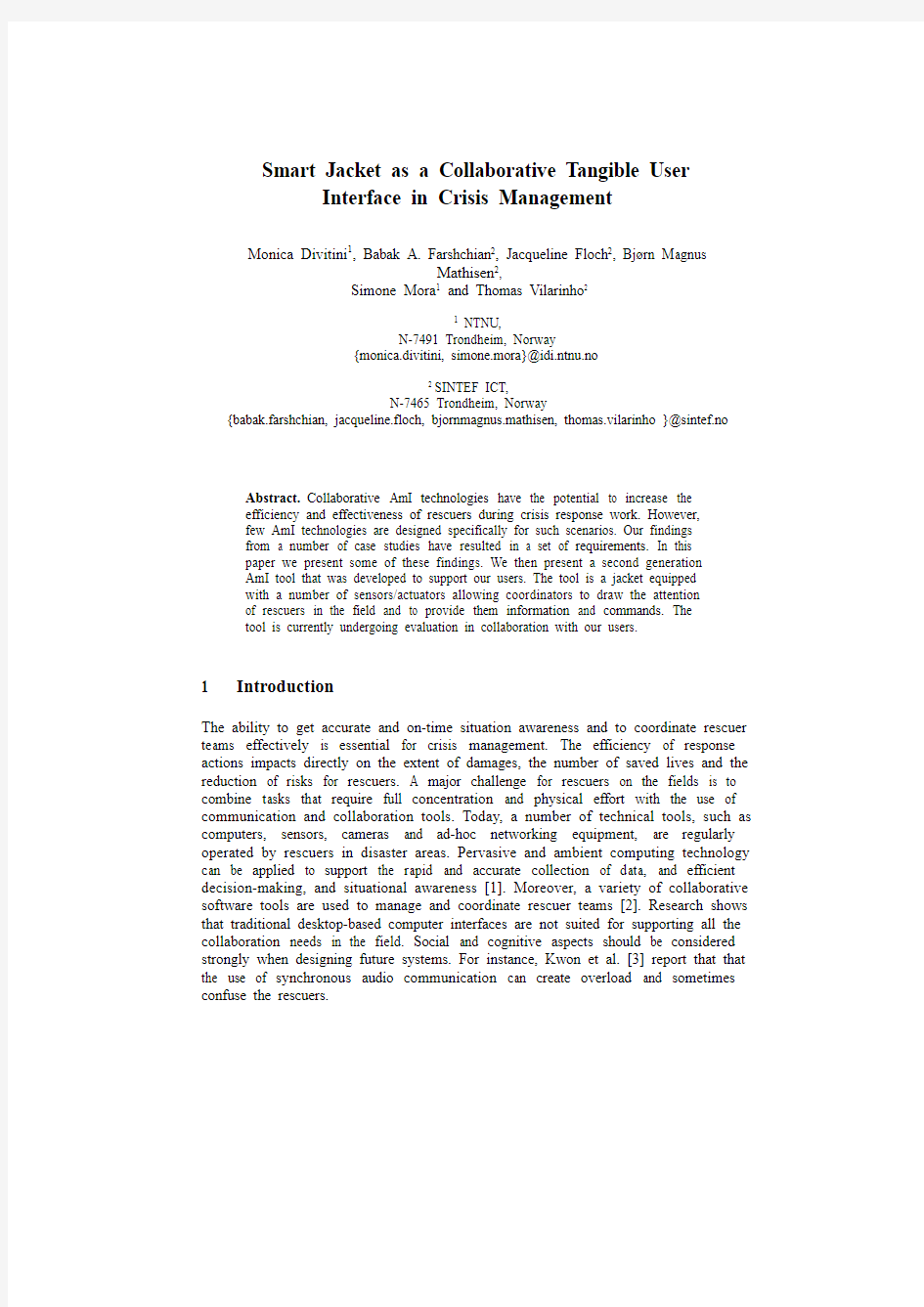危机公关案例分析英文版

- 1、下载文档前请自行甄别文档内容的完整性,平台不提供额外的编辑、内容补充、找答案等附加服务。
- 2、"仅部分预览"的文档,不可在线预览部分如存在完整性等问题,可反馈申请退款(可完整预览的文档不适用该条件!)。
- 3、如文档侵犯您的权益,请联系客服反馈,我们会尽快为您处理(人工客服工作时间:9:00-18:30)。
Smart Jacket as a Collaborative Tangible User
Interface in Crisis Management
Monica Divitini1, Babak A. Farshchian2, Jacqueline Floch2, Bjørn Magnus
Mathisen2,
Simone Mora1 and Thomas Vilarinho2
1 NTNU,
N-7491 Trondheim, Norway
{monica.divitini, simone.mora}@idi.ntnu.no
2 SINTEF ICT,
N-7465 Trondheim, Norway
{babak.farshchian, jacqueline.floch, bjornmagnus.mathisen, thomas.vilarinho }@sintef.no Abstract.Collaborative AmI technologies have the potential to increase the
efficiency and effectiveness of rescuers during crisis response work. However,
few AmI technologies are designed specifically for such scenarios. Our findings
from a number of case studies have resulted in a set of requirements. In this
paper we present some of these findings. We then present a second generation
AmI tool that was developed to support our users. The tool is a jacket equipped
with a number of sensors/actuators allowing coordinators to draw the attention
of rescuers in the field and to provide them information and commands. The
tool is currently undergoing evaluation in collaboration with our users.
1 Introduction
The ability to get accurate and on-time situation awareness and to coordinate rescuer teams effectively is essential for crisis management. The efficiency of response actions impacts directly on the extent of damages, the number of saved lives and the reduction of risks for rescuers. A major challenge for rescuers on the fields is to combine tasks that require full concentration and physical effort with the use of communication and collaboration tools. Today, a number of technical tools, such as computers, sensors, cameras and ad-hoc networking equipment, are regularly operated by rescuers in disaster areas. Pervasive and ambient computing technology can be applied to support the rapid and accurate collection of data, and efficient decision-making, and situational awareness [1]. Moreover, a variety of collaborative software tools are used to manage and coordinate rescuer teams [2]. Research shows that traditional desktop-based computer interfaces are not suited for supporting all the collaboration needs in the field. Social and cognitive aspects should be considered strongly when designing future systems. For instance, Kwon et al. [3] report that that the use of synchronous audio communication can create overload and sometimes confuse the rescuers.
2 Babak Farshchian et al.
This paper focuses on the user interface with the system. We explore tangible user interfaces that can be integrated in a smooth and non-intrusive manner in the rescuer environment, and plugged in and shared in a collaborative software tool. An example of such tangible interfaces, a smart jacket, is presented. In addition, related to cognitive aspects, we explain how the capabilities of the presented tool can be exploited to reduce abruptions when sharing information during a rescue.
This paper is structured as follows: Section 2 shortly introduces the research approach. Section 3 describes our findings from a number of case studies and observations of users. Section 4 and 5 describe our scenario and how our implementation can potentially solve some coordination problems for the rescuers. Section 6 presents the system implementation. Finally Section 7 concludes this paper and presents our future research plan.
2 Research approach
Our research follows the design science paradigm [4]. While behavioural-science approaches focus mainly on the use and benefits of a system implemented in an organization, design science approaches develop and evaluate IT artefacts intended to solve identified organizational problems. Developing such artefacts requires domain knowledge and justification in form of proper evaluations. The design science recursive process was used to develop our system.
Our research started with two sets of domain-related data from two European R&D projects, Mirror1 and SOCIETIES2. As part of the Mirror project, a set of case studies and observations involved rescuers from the Italian civil defence during a simulation of a massive disaster held in 2011 in Italy [5]. Another set of data came from focus groups and interviews with the European Urban Search And Rescue (USAR) as part of the SOCIETIES project [6]. The analysis of these data gave us a set of overall requirements that will be discussed in the next section. Based on this set of requirements we developed a first generation tool: a wristband developed using the Arduino platform3for the rescuer (see Figure 1), and a table-top interface for the coordinator[5]. Informal demonstrations of the tool for our users revealed several shortcomings in the tool. Based on this feedback we developed the second generation of the tool which is documented in the following sections in this paper. The second generation is also integrated with the collaboration-support platform being developed in the EU project SOCIETES, and in this way is also used as a proof-of-concept for that platform.
1 http://www.mirror-project.eu/
2 http://www.ict-societies.eu/
3 /
